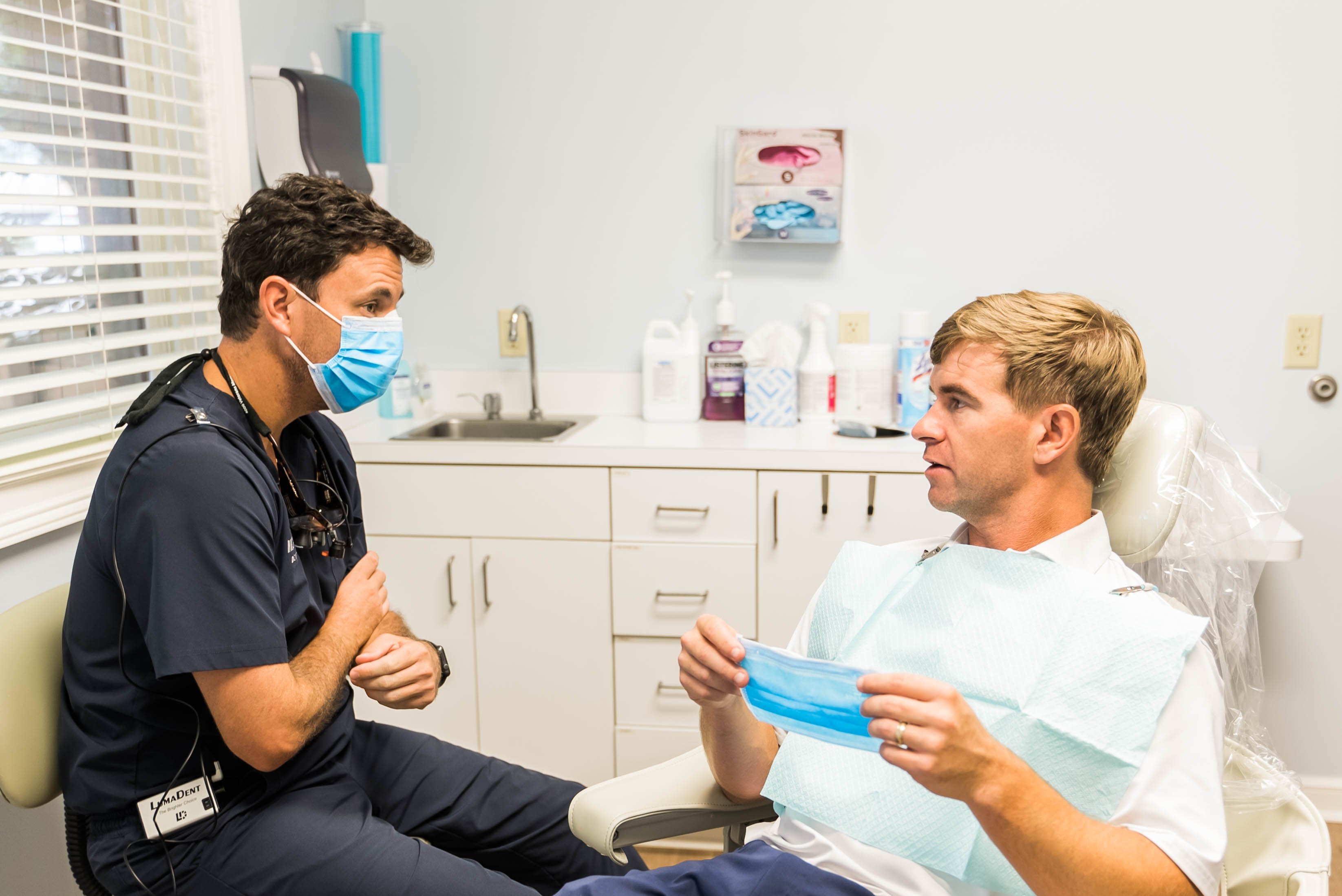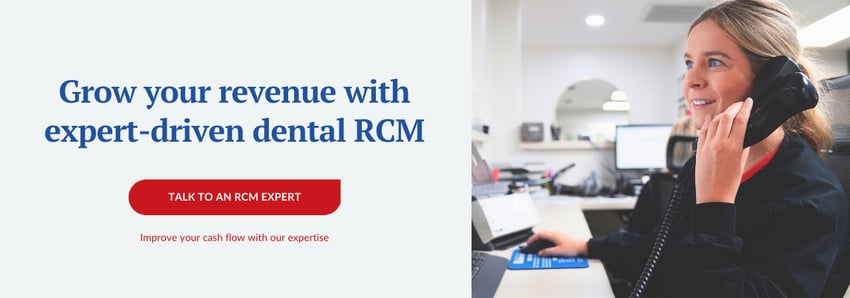How does a fee-for-service office submit dental claims?


A common belief is that fee-for-service (FFS) dental practices do not need insurance help from an outside source, such as a dental billing service. In most cases however, that’s actually not true!
Your fee-for-service dental practice may receive insurance reimbursement, even if you're out-of-network. What is a fee for service dental practice? How to file dental insurance claims as an FFS provider? Let's clear up how being an FFS dental practice can affect your insurance billing process.
Most fee-for-service providers are actually still submitting insurance claims, very similar to any in-network provider. At Dental Claim Support, we have helped numerous practices transition into (and out of) the fee-for-service environment since our inception in 2012. Our billing and claim consultants have seen many providers actually increase their production and insurance collections by removing PPOs from their practice.
One problem in the dental industry is that some understand the meaning of fee-for-service differently. So let’s clear up the terminology first.
In this article, we will explain what fee-for-service truly means, the way fee-for-service claims are submitted, and the various ways the dental practice is reimbursed by both the patient and dental insurance payers.
What does "fee-for-service" (FFS) mean in dentistry?
A fee-for-service dental practice model means the provider is not participating, or credentialed, with any insurance companies. Because the provider is not in a contract with any dental insurance, or PPO (Preferred Provider Organization), the fees being charged to the patient would be the standard office fees.
In the fee-for-service environment, the patient is responsible for the full cost of treatment, whether the patient has dental insurance or not. Patients with dental insurance can still be seen at a fee-for-service dental office, however, the patients will be financially responsible for any balance up to the full fee not paid by insurance benefits.
![DSC05661[1]](https://www.dentalclaimsupport.com/hs-fs/hubfs/DSC05661%5B1%5D.jpg?width=576&name=DSC05661%5B1%5D.jpg)
How does a FFS dental practice submit a dental claim?
Using the 2019 version of the ADA American Dental Association Dental Claim Form, box 37 will dictate if the dental practice or patient will be reimbursed from a dental insurance company. This is known as “assignment of benefits.”

.png?width=469&name=unnamed%20(1).png)
Box 37 states: “I hereby authorize and direct payment of the dental benefits otherwise payable to me, directly to the below named dentist or dental entity.” If the subscriber (or patient) signs and dates this line, the dentist or the dental entity will be reimbursed from the dental insurance company.
Side note: Patients themselves rarely sign this claim form, but rather the subscriber, patient or authorized person signs an assignment of benefits indicating all benefits from any insurance are payable to the practice. The dental software would complete the form by stating “signature on file” and adding the date of service to the signature line.
If the Subscriber Signature line in box 37 is left blank, the dental insurance will then send the reimbursement check directly to the patient.
What options does a FFS dental practice have to obtain reimbursement for services?
Fee-for-service dental practices can decide how they want to be reimbursed for services, and there are 3 options for reimbursement. This decision is solely up to the practice.
1. The provider does not file dental claims at all
In the first scenario, a fee-for-service dental practice will not file any dental claims on the patient’s behalf. The patient will be required to pay the entire visit fee at the time of treatment.
Patients would then be given a pre-filled ADA insurance claim form from the dentist to file on their own behalf. The dental insurance would then pay the patient directly any and all reimbursement they are owed.
In this scenario, the dental practice would not be responsible for filing or checking up on any outstanding dental claims and would have zero accounts receivable. However, the practice is responsible for responding to any requests for additional information from the insurance payer.
In other words, the practice cannot just give the patient the information to file their own claims and consider their job is complete with the claim.
![DSC05793[1]](https://www.dentalclaimsupport.com/hs-fs/hubfs/DSC05793%5B1%5D.jpg?width=620&name=DSC05793%5B1%5D.jpg)
2. The provider does file dental claims but wants the dental insurance company to reimburse the patient
In this second scenario, a dental practice may choose to file the claims on the patient's behalf, leaving box 37 unchecked on the 2019 ADA Dental Claim Form. The dental practice is going to collect the full fee from the patient before sending the claim to the insurance.
With box 37 unchecked, the insurance payer is going to send all Explanation of Benefits (EOBs) to the patient. The dental office is likely not going to receive any notification of payment or denial from the insurance company.
In this case, the dental practice then has a couple options of how they follow up on claims and when they decide to close the claim in their dental software. If the office is not expecting to be paid from insurance, the open claim would then need to be closed immediately in the dental software.
To follow up on outstanding claims, the office can either follow up on claims regularly, or wait for a patient request. If the patient is responsible for their own claim follow-up, they may run into denial issues, resubmission issues, or even timely filing issues.
With the patients receiving the EOBs, the dental insurance is not required to give any information regarding the claim or payment information to anyone besides the patient. For example, the dental practice can call to check the status of a claim, but the insurance may not give any information regarding whether a claim was paid, or how much was paid on the claim to the patient.
3. The provider does file dental claims and wants to be reimbursed from dental insurance
In this third and final scenario, a fee-for-service dental practice can submit claims for their patients. The dental practice is going to estimate the patient-owed amount based on insurance verification, or a Pre-Determination, before sending the claim to the insurance. The patient may only be required to pay their copay or patient portion at the time of service.
When the practice is FFS, the insurance payer cannot dictate the fee charged to the patient. The dental practice is taking the responsibility for filing and checking up on any outstanding dental claims in order to receive reimbursement from the dental insurance companies.
Can outsourced dental billing companies help practices that are “fee-for-service”?
We can’t speak for other dental billing companies, but at Dental Claim Support (DCS), we do work with FFS dental offices when the provider does file claims and wants to be reimbursed from dental insurance, as seen above in scenario 3.
Even when an office is out-of-network with all insurance payers, if they are filing claims, there are important steps Dental Claim Support can still take to eliminate insurance strain. For example: claims still need to be filed, and filed correctly.
Dental Claim Support will handle filing claims for your practice to make sure the claims go out as clean claims and pay as quickly as possible. Along those lines, if claims are denied, we will complete the appeals process for you.
When can an outsourced dental billing not help with fee-for-service offices?
Unfortunately, an outsourced dental billing, like Dental Claim Support, cannot help a practice that does not file insurance claims at all, like scenario 1 above. If there are no claims, this type of practice would not need insurance and dental billing support.
Scenario 2 above, The provider does file claims but wants the dental insurance company to reimburse the patient, is very inefficient for any insurance coordinator or an outsourced dental billing company, and here’s why: This scenario is creating extra work for the dental practice. Claims are being created and then need to be closed. Some offices may want to wait to close claims and oftentimes, never close claims.
Failing to close claims creates major problems in your dental software in the long run. Instead of EOBs coming to the office to be worked, all EOBs are going to the patients instead, thus the follow-up required would double, if not triple the amount of work required to follow up on claims.
Outsourced dental billing companies could help with this scenario, but be prepared for a higher price tag in most instances due to the extra amount of research and work required.
Are you considering out-of-network and going FFS?
Most providers are asking themselves (and their peers) this question: “Can I go out-of-network with Delta Dental?” Most are asking this question because a high percentage of their patient base is either Delta Dental PPO or Dental Dental Premier, and the fees are extremely low (and we all know a significant increase is highly unlikely anytime soon).
Delta Dental has almost created a hybrid version of scenarios 2 and 3 above, but not the provider’s choice. The office is fee-for-service but still wants to be reimbursed for their services by the insurance company.
Delta Dental has decided that if you go out-of-network with them, they will send the reimbursement check directly to the patient when allowed by state law, no matter what you do on the claim form in item 37. Collecting from patients in this scenario can be very difficult because the patient is not prepared to pay for their services in full at their time of service, while they also tend to cash their checks from Delta Dental and decide not to reimburse the office (which happens more than you think).
Delta Dental is creating more work for the office (Scenario 2) while the office is trying to operate normally by reimbursing the office (Scenario 3). This tends to be a difficult decision to make for most providers, and as much as providers dislike the low PPO reimbursement rates, they also want to be reimbursed for their services. Unfortunately for most, it’s a “catch 22.”
Note: Delta Dental is used as an example in this article for illustration purposes only because Delta Dental brand is well known as one of the largest payers and third party administrators for dental plans. Other payers have policies similar to those addressed in this article.
Who can I lean on for support to help my dental practice transition to Fee-for-Service?
Dental Claim Support has been able to help dental providers through this discussion and handling of dental claims to support those considering going out-of-network. Getting higher reimbursement rates is the main goal of the provider, but getting the provider’s claims paid is the ultimate goal for Dental Claim Support.
If you are considering going FFS and you are looking for more insights, consider joining a mastermind group with other dental providers just like you. Hear from others about what they have done, how they have done it, and how to deal with all around insurance stress.
Related Posts
Dental revenue resources from Dental Claim Support
.png)
